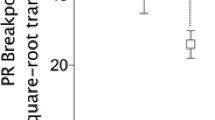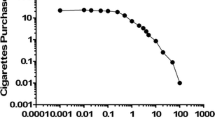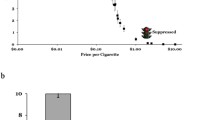Abstract
Rationale
Characterisation of drug dependence using principles from behavioural economics has provided a more detailed understanding of the disorder. Although questionnaires assessing economic demand for cigarettes have extended these principles to nicotine addiction, aspects of the reliability and selectivity of these questionnaires remain uncertain.
Objective
Across two experiments, we attempted to reproduce significant associations of the cigarette purchase task with nicotine dependence in a young adult population of smokers and contrasted this measure with a novel chocolate purchase task. We also examined the association between these measures and performance on a preference task, measuring preference for cigarettes and chocolate.
Methods
Questionnaire measures were used within a university setting.
Results
In experiment 1, we observed associations between nicotine dependence and measures of behavioural economic demand for cigarettes, particularly O max. In experiment 2, we replicated these findings again and extended them to show that similar correlations between nicotine dependence and demand for chocolate were not observed. Moreover, the indices of demand and choices on a concurrent choice cigarette task were moderately associated with each other and independently associated with nicotine dependence.
Conclusions
The two experiments clearly supported previous findings regarding the association between nicotine dependence and economic demand for cigarettes. We extend these observations by showing that the generalisation of economic demand across different commodities is relatively weak, but that generalisation across different procedures is strong. Our results therefore support behavioural economic models of nicotine addiction which emphasise a robust proximal role for the incentive value of cigarettes.


Similar content being viewed by others
References
Amlung MT, Acker J, Stojek MK, Murphy JG, MacKillop J (2012) Is talk “cheap”? An initial investigation of the equivalence of alcohol purchase task performance for hypothetical and actual rewards. Alcohol Clin Exp Res 36:716–724
Bickel WK, Madden GJ (1999) A comparison of measures of relative reinforcing efficacy and behavioral economics: cigarettes and money in smokers. Behav Pharmacol 10:627–637
Bickel WK, Marsch LA, Carroll ME (2000) Deconstructing relative reinforcing efficacy and situating the measures of pharmacological reinforcement with behavioral economics: a theoretical proposal. Psychopharmacology (Berl) 153:44–56
Bidwell LC, MacKillop J, Murphy JG, Tidey JW, Colby SM (2012) Latent factor structure of a behavioral economic cigarette demand curve in adolescent smokers. Addict Behav 37:1257–1263
Bradshaw CM, Killeen PR (2012) A theory of behaviour on progressive ratio schedules, with applications in behavioural pharmacology. Psychopharmacology (Berl) 222:549–564
Buhler M, Vollstadt-Klein S, Kobiella A, Budde H, Reed LJ, Braus DF, Buchel C, Smolka MN (2010) Nicotine dependence is characterized by disordered reward processing in a network driving motivation. Biol Psychiatry 67:745–752
Christensen CJ, Silberberg A, Hursh SR, Roma PG, Riley AL (2008) Demand for cocaine and food over time. Pharmacol Biochem Behav 91:209–216
Diergaarde L, Pattij T, Nawijn L, Schoffelmeer AN, De Vries TJ (2009) Trait impulsivity predicts escalation of sucrose seeking and hypersensitivity to sucrose-associated stimuli. Behav Neurosci 123:794–803
Epstein LH, Dearing KK, Roba LG (2010) A questionnaire approach to measuring the relative reinforcing efficacy of snack foods. Eat Behav 11:67–73
Etter JF, Le Houezec J, Perneger TV (2003) A self-administered questionnaire to measure dependence on cigarettes: the cigarette dependence scale. Neuropsychopharmacology 28:359–370
Few LR, Acker JE, Murphy CM, MacKillop J (2012) Temporal stability of a cigarette purchase task. Nicotine Tob Res 14(6):761–765
Hogarth L (2012) Goal-directed and transfer-cue-elicited drug-seeking are dissociated by pharmacotherapy: evidence for independent additive controllers. J Exp Psychol Anim Behav Process 38:266–278
Hogarth L, Chase HW (2011) Parallel goal-directed and habitual control of human drug-seeking: implications for dependence vulnerability. J Exp Psychol Anim Behav Process 37:261–276
Hogarth L, Chase HW (2012) Evaluating psychological markers for human nicotine dependence: tobacco choice, extinction, and Pavlovian-to-instrumental transfer. Exp Clin Psychopharmacol 20:213–224
Hursh SR, Galuska CM, Winger G, Woods JH (2005) The economics of drug abuse: a quantitative assessment of drug demand. Mol Interv 5(1):20–8
Hursh SR, Silberberg A (2008) Economic demand and essential value. Psychol Rev 115:186–198
Jacobs EA, Bickel WK (1999) Modeling drug consumption in the clinic using simulation procedures: demand for heroin and cigarettes in opioid-dependent outpatients. Exp Clin Psychopharmacol 7:412–426
MacKillop J (2006) Factor structure of the alcohol urge questionnaire under neutral conditions and during a cue-elicited urge state. Alcohol Clin Exp Res 30:1315–1321
MacKillop J, Murphy JG (2007) A behavioral economic measure of demand for alcohol predicts brief intervention outcomes. Drug Alcohol Depend 89:227–233
MacKillop J, Tidey JW (2011) Cigarette demand and delayed reward discounting in nicotine-dependent individuals with schizophrenia and controls: an initial study. Psychopharmacology (Berl) 216:91–99
MacKillop J, Murphy JG, Ray LA, Eisenberg DT, Lisman SA, Lum JK, Wilson DS (2008) Further validation of a cigarette purchase task for assessing the relative reinforcing efficacy of nicotine in college smokers. Exp Clin Psychopharmacol 16:57–65
MacKillop J, Murphy JG, Tidey JW, Kahler CW, Ray LA, Bickel WK (2009) Latent structure of facets of alcohol reinforcement from a behavioral economic demand curve. Psychopharmacology (Berl) 203:33–40
MacKillop J, Miranda R Jr, Monti PM, Ray LA, Murphy JG, Rohsenow DJ, McGeary JE, Swift RM, Tidey JW, Gwaltney CJ (2010) Alcohol demand, delayed reward discounting, and craving in relation to drinking and alcohol use disorders. J Abnorm Psychol 119:106–114
McClure EA, Vandrey RG, Johnson MW, Stitzer ML (2012) Effects of varenicline on abstinence and smoking reward following a programmed lapse. Nicotine Tob Res. doi:10.1093/ntr/nts101
Murphy JG, MacKillop J (2006) Relative reinforcing efficacy of alcohol among college student drinkers. Exp Clin Psychopharmacol 14:219–227
Murphy CM, Mackillop J (2011) Factor structure validation of the Alcohol Dependence Scale in a heavy drinking college sample. J Psychopathol Behav Assess 33:523–530
Murphy JG, MacKillop J, Skidmore JR, Pederson AA (2009) Reliability and validity of a demand curve measure of alcohol reinforcement. Exp Clin Psychopharmacol 17:396–404
Murphy JG, MacKillop J, Tidey JW, Brazil LA, Colby SM (2011) Validity of a demand curve measure of nicotine reinforcement with adolescent smokers. Drug Alcohol Depend 113:207–214
Murphy JG, MacKillop J, Vuchinich R, Tucker J (2012) Behavioral economic concepts in the analysis of substance abuse. In: Walters S, Morgenstern J, Rotgers F (eds) Treating substance abuse, theory and technique. Guilford Press, New York
O'Loughlin J, DiFranza J, Tyndale RF, Meshefedjian G, McMillan-Davey E, Clarke PB, Hanley J, Paradis G (2003) Nicotine-dependence symptoms are associated with smoking frequency in adolescents. Am J Prev Med 25:219–225
Tucker JA, Vuchinich RE, Rippens PD (2002) Predicting natural resolution of alcohol-related problems: a prospective behavioral economic analysis. Exp Clin Psychopharmacol 10:248–257
Tucker JA, Vuchinich RE, Black BC, Rippens PD (2006) Significance of a behavioral economic index of reward value in predicting drinking problem resolution. J Consult Clin Psychol 74:317–326
Acknowledgments
This work was supported by a Medical Research Council grant G0701456 and NIH grant K23 AA016936.
Conflict of interest
The authors declare that they have no conflicts of interest.
Author information
Authors and Affiliations
Corresponding author
Rights and permissions
About this article
Cite this article
Chase, H.W., MacKillop, J. & Hogarth, L. Isolating behavioural economic indices of demand in relation to nicotine dependence. Psychopharmacology 226, 371–380 (2013). https://doi.org/10.1007/s00213-012-2911-x
Received:
Accepted:
Published:
Issue Date:
DOI: https://doi.org/10.1007/s00213-012-2911-x




